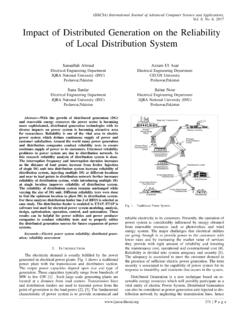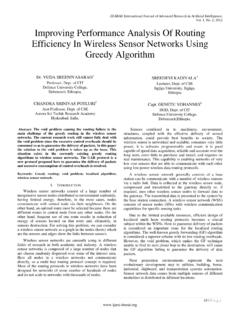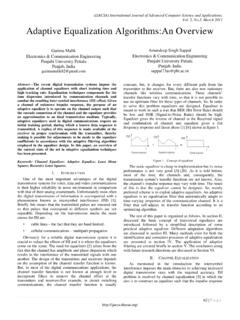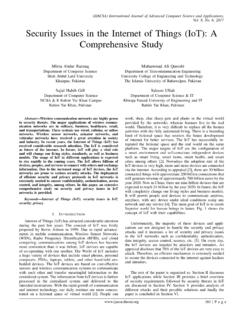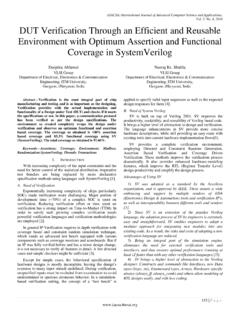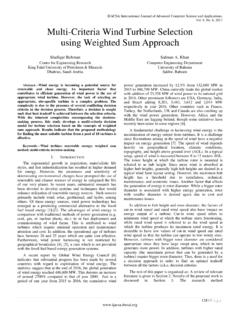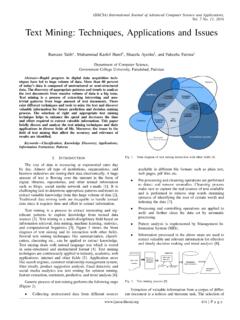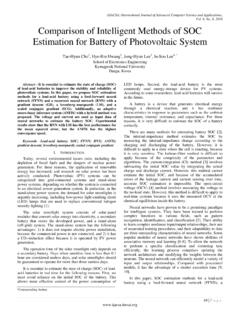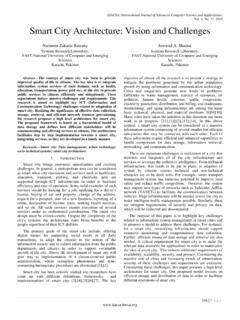Transcription of Media Content Access: Image-Based Filtering - …
1 (IJACSA) International Journal of Advanced Computer Science and Applications, Vol. 9, No. 3, 2018 415 | P a g e Media Content Access: Image-Based Filtering Rehan Ullah Khan1, Ali Alkhalifah2 Information Technology Department Qassim University, Al-Qassim, KSA Abstract As the Content on the internet contains sensitive adult material, Filtering and blocking this Content is essential for the social and ethical values of the many societies and organizations. In this paper, the Content Filtering is explored from still images perspectives. Thus, this article investigates and analyses the Content based Filtering which can help in the flagging of the images as adult nature or safe images. As the proposed approach is based on the Chroma (colour) based skin segmentation and detection for detecting the objectionable Content in images; therefore, the approach proceeds in the direction of the classical Machine Learning approaches and uses the two well-known classifiers: 1) The Random Forest; and 2) the Neural Network.
2 Their fusion is also investigated. Skin colour is analyzed in the YCbCr colour space and in the form of blob analysis. With the Adult vs. Safe classification, an Accuracy of and the low RMSE of is achieved, indicating the usefulness of the detection model. Keywords Skin detection; Content based Filtering ; Content analysis; machine learning; random forest; neural network I. INTRODUCTION The most famous influential Media platforms that allow the users to upload the recorded Content (images and videos) are the Flickr, Facebook, Twitter, YouTube, and the DailyMotion. This is not limited to the social platforms. In fact, the internet itself is a gigantic and a general platform for digital Media including images and videos resources. The Content uploaded to platforms and the Internet itself is increasing rapidly as more and more people are finding access and enjoying the services provided by these providers.
3 The negative side is that the Media Content ; however, is becoming more and more liberal and one can easily access and see the partially/fully naked images on the internet. This opens risks in terms of many social factors. One of the major problems is the availability of these resources to the younger generation. The most feared element, however, nowadays is the availability of these Media resources to the kids. Therefore, in this paper, we analyze skin color based image Content filter which can help in the flagging of the images as adult nature or safe images. As the proposed approach is based on color based skin segmentation and detection for detecting the objectionable Content in images, therefore, we proceed in the direction of the classical Machine Learning approach and use the two well-known classifiers: The Random Forest and the Neural Network.
4 For skin color analysis, we also investigate their fusion. We analyze skin color in the YCbCr color space and in the form of blob analysis. With the Adult vs Safe classification, we get an Accuracy of and the low RMSE of , indicating the usefulness of our detection model. The success of this filter can have profound applications in Media Filtering which will benefit not only the general society but also will be especially, useful for parental control over the Media for the children and similar requirements. The basic filter developed can be further extended for videos and online streaming like YouTube and other resources. Certain IP level porn and adult Content blocking is possible, however, blocking the user s Content on the IP level is always by-passable as there is certain Proxy bypassing tools available to bypass the restrictions and access the corresponding resources containing explicit Content .
5 Therefore, blocking and Filtering the multimedia based on its Content is of utmost importance. There is interesting work available in the state-of-the-art regarding Content based retrieval [1], [2], skin detection [3], [4], and Content based Filtering [5]. In [5], the authors propose a method combining evidence including video sequences, key shots, and key frames and evaluating performance with three the social networks. The work in [6] describes a sampling, based on the adaptive sampling analysis achieving an acceptable detection rates of 87%. The author in [7] use bag of visual words approach for Filtering and blocking nude images using the associated voting scheme, analyzed and evaluated achieving Accuracy. The work in [8] targets skin locus detection for Content Filtering using the 24 colors transformations in widely available images and videos.
6 The framework of [9] produces an augmented classification model with independent of the access scenarios with the promising results. The authors in [10] combines the key-frame based approaches with a statistical MP4 motion vectors. Generally, Image and Video Retrieval (IVR) paradigm is divided into two directions. One that uses Media Content directly by taking advantage of the visual information present in the images and videos. This type of approach is generally termed as the Content -Based Image and Video Retrieval (CBIVR). In CBIVR, the images and videos are retrieved and searched using the low-level features, for example, color, shape, texture and pixel relationships [11], [12]. Another approach that is nowadays advocated in conjunction with CBIVR is the Textual-Based Image and Video Retrieval (TBIVR).
7 The textual analysis of images and videos uses mostly the tags assigned during the production of the Media source. In order to overcome the limitations and drawbacks of the CBIVR, the TBIVR gracefully represent the visual information during the production or editing phase by users manually assigned keywords and or tags. The systems can also allow for later assignments of tags, however, this might introduce wrong tags and tags that are unnecessary. The TBIVR systems allow the users to type the information need as a text query. (IJACSA) International Journal of Advanced Computer Science and Applications, Vol. 9, No. 3, 2018 416 | P a g e In [13], the authors analyze Content Filtering for a Web-based P2P using the Machine learning to filter the explicit Content and results show the feasibility of the approach.
8 The work in [14] uses two visual features and are constructed from the video in question using decision variable based on the single frame and a group of frames. In [15], authors use the Hue-SIFT for nude and explicit Content detection. In [16], authors propose visual motion analysis approach augmenting the visual motion features with the audio repetition in video. The [17] demonstrate a multimodal hierarchy based Filtering for explicit Content . The algorithm is made of 3 phases, Detecting initial video scene using the hashing signatures, real-time detection estimating the degree of explicit Content , and finally, exploiting features from frame-group and thus achieving high detection rate. The authors in [18] uses optical flow for Content Filtering based on the selection of the frame as the key-frame.
9 The work in [19] use similar approach of the motion estimation. In [20], authors present an objectionable (porn) video Filtering approach using a fusion of audio features and video features. Training the Support Vector Machine (SVM) on the chromatic and texture cues of the SIFT key points for adult image frames integrated by the Bayes statistics for classification. II. COLOR BASED SKIN DETECTION For Content Filtering in still images, the basic feature for the detection starts with a reliable color based skin locus detection in images. We start with the experimental setup of the robust skin analysis using color features in the YCbCr color space. As the proposed approach is based on the Chroma (color) based skin segmentation and detection, therefore, we use the two well-known classifiers: The Random Forest and the Neural Network, selecting them due to the good classification performance in many related tasks.
10 III. CLASSIFICATION As the proposed approach is based on the Chroma (colour) based skin segmentation and detection for detecting the objectionable Content in images, therefore, we proceed in the direction of the classical Machine Learning approaches and use the two well-known classifiers: The Random Forest and the Neural Network. We also investigate their fusion in the Experiment section. A. Random Forest Recently, the tree based classifiers have gained considerable popularity. This popularity stems from the intuitive nature and the overall easy training paradigm. Classification trees, however, suffer from the classification and generalization accuracy. It is not possible to increase both the classification and generalization accuracy at the same time.
